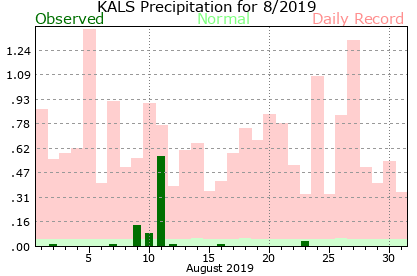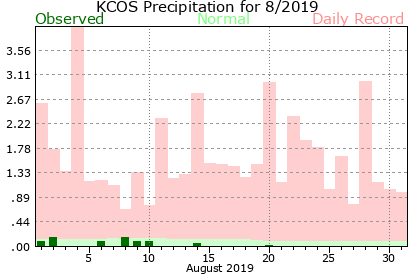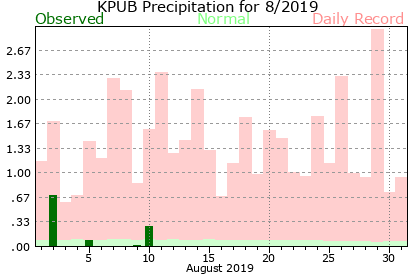August of 2019 was generally hot and dry across south central and southeast Colorado, as upper level high pressure persisted across the Desert Southwest and Four Corners region, which limited the amount of monsoonal moisture moving into the region.
For the month of August as a whole, above normal temperatures and below normal precipitation were experienced across south central and southeast Colorado, save for a few pockets of above normal precipitation.
The following graphics depict monthly temperature and precipitation departures from normal across the state for the past month of August.
.png) |
.png) |
The preliminary average temperature in Alamosa for the past month of August was 64.2 degrees. This is 1.5 degrees above normal and makes August of 2019, tied with August of 1955 and 1937, as the 13th warmest August on record. Alamosa recorded 0.85 inches of precipitation through out the month of August, which is 0.42 inches below normal. .
.png) |
 |
The preliminary average temperature in Colorado Springs for the past month of August was 73.1 degrees. This is 4.4 degrees above normal and makes August of 2019 the 2nd warmest August on record, just behind the average temperature of 74.1 degrees recorded in August of 2011. Colorado Springs recorded 0.71 inches of precipitation through out the month of August. This is 2.63 inches below normal and makes August of 2019 the 9th driest August on record. This remains well behind the driest August on record, 2012, when only 0.12 inches of precipitation was recorded in Colorado Springs.
.png) |
 |
The preliminary average temperature in Pueblo for the past month of August was 78.1 degrees. This is 4.7 degrees above normal and makes August of 2019 the 5th warmest August on record. This remains well behind the warmest August on record, 1970, when the average temperature in Pueblo was 79.8 degrees. Pueblo recorded 1.05 inches of precipitation through out the month of August, which is 1.27 inches below normal.
.png) |
 |
Looking ahead into September, in Alamosa, the average high and low temperature of 77 degrees and 43 degrees on September 1st, cool to 68 degrees and 31 degrees by the end of the month. The average temperature for the month of September in Alamosa is 55 degrees. Alamosa averages 0.91 inches of precipitation through out the month of September. On average, September 11th is the date of the first freeze in Alamosa.
In Colorado Springs, the average high and low temperature of 79 degrees and 53 degrees on September 1st, cool to 69 degrees and 41 degrees by the end of the month. The average temperature for the month of September in Colorado Springs is 60.9 degrees. Colorado Springs averages 1.19 inches of precipitation through out the month of September. On average, Colorado Springs also receives 0.2 inches of snow in the month of September.
In Pueblo, the average high temperature and low temperature of 87 degrees and 54 degrees on September 1st, cool to 76 degrees and 41 degrees by the end of the month. The average temperature for the month of September in Pueblo is 64.7 degrees. Pueblo averages 0.77 inches of precipitation through out the month of September. On average, Pueblo also receives 0.3 inches of snow in the month of September.
Below is the Climate Prediction Center's (CPC) temperature and precipitation outlook for the month of September, which gives slightly better chances of seeing above normal temperatures across south central Colorado, with equal chances of above, below and near normal temperatures across southeast Colorado. As for precipitation, there is a slight nod to above normal readings across all of south central and southeast Colorado.
.gif) |
.gif) |